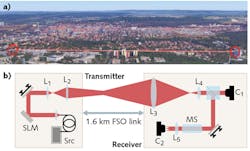Free-space Optical Communications: Atmospheric turbulence model highlights hurdles to FSO communications using twisted OAM light
Atmospheric changes in temperature and pressure that affect the refractive index and optical density of the air and, in turn, confound the transmission of optical signals have long been a major hurdle to successful free-space optical (FSO) communications. Atmospheric turbulence corrupts the phase purity of propagating optical beams, making it difficult to perform space-division multiplexing (SDM) and quantum-key distribution (QKD) functions, even for twisted light with orbital angular momentum (OAM) and its multiple modes with different helical phase.
To better understand the hurdles to successful FSO transmission, researchers from the University of Glasgow in Scotland, the Max Planck Institute (Erlangen, Germany), and the Universities of Otago (Dunedin, New Zealand), Ottawa (Ottawa, ON, Canada), and Rochester (Rochester, NY) developed a comprehensive model to study the effects of atmospheric changes on the phase of OAM beams and tested the model’s viability in a 1.6 km FSO link over the city of Erlangen in Germany. The model reveals weaknesses in prior simulations, and concludes that complex adaptive optics would be necessary for successful FSO transmission of OAM beams at lengths >500 m.
A better turbulence model
The thin-phase model, which approximates the longitudinally varying phase retardance because of local atmospheric changes in optical density as a perturbing spatial phase profile in a single plane, is only valid for short FSO links on the order of a few hundred meters. Even though this thin-phase and other propagation models say that the spatial intensity of a laser beam is preserved for FSO distances up to 143 km, preservation of the phase profile of these modes is not well understood.
The model used by the researchers looks at atmospheric tip-tilt and higher-order aberrations and impure modal generation as it affects the channel crosstalk between nine particular OAM modes with ℓ = 0, ±1, ±2, ±3, and 4, where ℓ represents the number and direction of the intertwined phase helices in the optical field. During FSO transmission of these beams in the 1.6 km Erlangen link, current atmospheric turbulence models show that beams with ℓ >1 split in free space result in a change in measured average OAM of the received beam, making these beams unsuitable for SDM and QKD applications (see figure).
Tip-tilt measurements, taken to be the center of mass of a received Gaussian beam, recorded an average radial variation of 18 mm from center for the various modes measured. Higher-order mode measurements, defined as the full-width half-maximum (FWHM) of the point-spread function of the ℓ = 0 mode at the receiver, show very stringent requirements on the aperture of the FSO system and the modes that can be used for long-distance propagation.
For example, for a beam with ℓ = 4, a vortex-splitting ratio of V <0.03 (where V is defined as the average radial distance from the beam origin for the individual vortices divided by the transmitted-mode beam waist) must be maintained to achieve a >99% mode purity, which is necessary for error-free transmission. The actual measurements from Erlangen showed values of V much higher at V = 0.2—nearly an order of magnitude higher than required.
Regardless of whether atmospheric turbulence or system issues such as back-reflection and/or light scattering explain vortex splitting and its associated phase degradation, it is obvious that OAM beams beyond ℓ = 1 will require adaptive optics.
"FSO links offer the opportunity to radically rethink the structure of the ‘last mile’ of digital network infrastructure, where a physically adaptive network could be deployed that dynamically restructures the optical links as required on a city scale," says Martin Lavery, Structured Photonics Research Group leader at the University of Glasgow. "To enable such a smart city, we need connections that can rival fiber-optical network bandwidth, but with the flexibility of cable-free connections. The use of spatial modes, such as those that carry orbital angular momentum, could allow optical free-space links to carry multiple channels similar to the fiber bundles that get deployed in underground fiber links. Our published work takes a big step towards reaching this challenge, where we have fully analyzed the turbulent effect on these spatial modes and highlight the route forward for developing real systems that could be deployed in urban environments."
REFERENCE
1. M. P. J. Lavery et al., Sci. Adv., 3, 10, e1700552 (Oct. 25, 2017).

Gail Overton | Senior Editor (2004-2020)
Gail has more than 30 years of engineering, marketing, product management, and editorial experience in the photonics and optical communications industry. Before joining the staff at Laser Focus World in 2004, she held many product management and product marketing roles in the fiber-optics industry, most notably at Hughes (El Segundo, CA), GTE Labs (Waltham, MA), Corning (Corning, NY), Photon Kinetics (Beaverton, OR), and Newport Corporation (Irvine, CA). During her marketing career, Gail published articles in WDM Solutions and Sensors magazine and traveled internationally to conduct product and sales training. Gail received her BS degree in physics, with an emphasis in optics, from San Diego State University in San Diego, CA in May 1986.
